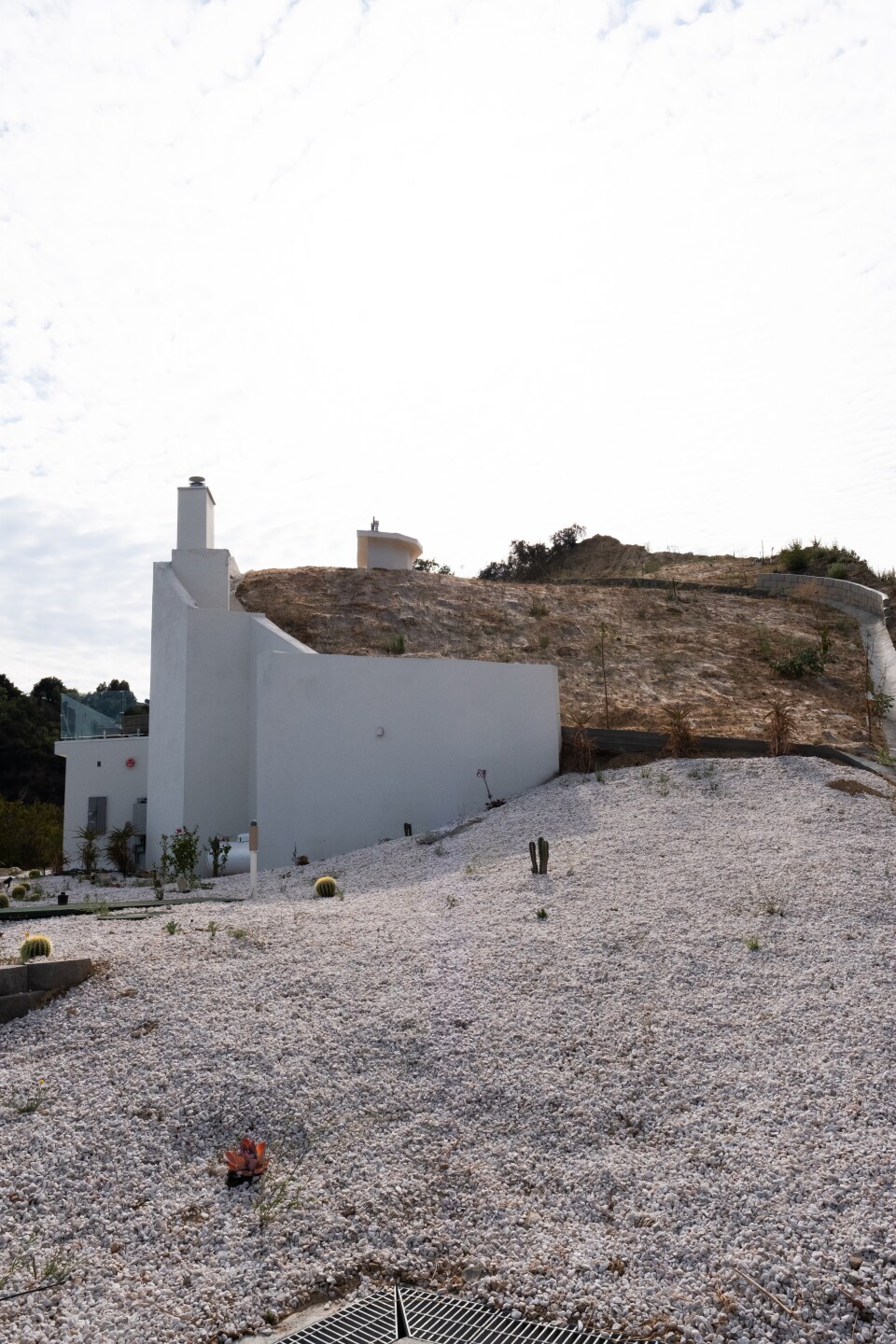Truth matters. Community matters. Your support makes both possible. LAist is one of the few places where news remains independent and free from political and corporate influence. Stand up for truth and for LAist. Make your year-end tax-deductible gift now.
This LA home was built to be fireproof. Will it survive the next major blaze?

Just a few weeks ago, I wrote about how an unstoppable fire could easily blow through Topanga Canyon, potentially in just a handful of hours, trapping motorists and residents, leading to a Paradise like situation.
In short, strong winds, steep hills, narrow roads and huge amounts of long unburned vegetation, make building a home there quite dangerous. Throughout most of the canyon you'll find typical, vulnerable wood frame houses tucked in between the laurel sumac.
But while I was reporting for my wildfire podcast The Big Burn, I came across a structure like no other, that seemed to disappear into the hillside around it. And, once I spoke with the builder, I found out that embedding the home under a mountain of dirt was done, in part, to make his place resistant to even the worst wildfires that might blow through Topanga.
Even if you frequent the main road through the area, odds are that you probably haven't even noticed it, because from the backside, the property looks just like any other dirt hill dotted with chaparral.
But turn down a driveway the front of the house reveals itself.
All you'll see are windows surrounded by large white walls, with concrete and gravel at the base.
There are no eaves to burn, no mass of material (like mulch) pressed right up against the structure that could carry a flame and melt windows and no fence to catch on fire.
Instead of wood siding, there’s smooth white stucco.

The biggest problem area might be the small piece of roof sticking up from the dirt. And it wouldn't be a bad move to trim some of the larger plants back from the front of the structure. But kept free of vegetation and mulch, and it seems like the house would probably do fine.
The building process
The body of the home is made of a four-plus-inch thick reinforced concrete shell, designed by the company Formworks, out of Colorado.
After the hillside was excavated, builders put up a big steel frame, filled it with foam, and blasted it with layer upon layer of concrete. They then pulled out the foam, covered the shell up with tons of dirt, and built up the interior like any other house.
A very difficult process
You can see the process documented above by the guy who was responsible for building the house, stuntman Eddie Conna, who has 140 different credits to his name, including Natural Born Killers, Mr. and Mrs. Smith, and the Fast & Furious franchise.

“I had a friend of mine who I grew up with who told me, ‘What I find interesting about you is you do some of the craziest s..t, but you do it in the safest way possible.’ And that was kind of always my mindset,” Conna told me last year, when I spoke with him for the podcast.
He first came across the idea of an in-ground dome home back in the early 2000s, when he wanted to build a multi-story house in Chatsworth, another L.A. location with high fire risk.
A thick concrete shell buried in the ground was initially attractive to him because of its promising insulation.
“I saw where utility bills were going. It started with the energy efficiency,” Conna said. “Then as I did more research, it was, 'oh, geez, I'm building something that is also resistant to fires'.”
It took him about three years to finish the project, and when a fire tore through the area, threatening homes, it survived unscathed.
“I mean, there was a piece of me that was like, you're gonna be okay, because three sides of the house are buried, and the amount of exposure you have to a fire is minimal,” he said.
Conna was so inspired by the resilience of the house that he thought it’d be a perfect choice for building in Topanga.

Though, things didn’t go nearly as smoothly as they did with his first spot.
While Chatsworth took three years, the Topanga home took 13 year, and cost him $1.1 million to build, double what he first budgeted.
The whole time he struggled with permitting and construction issues, in part, he thinks, because his approach to building a home was so different from what anyone was used to.
“By the end of the process, I wasn't sleeping, I was talking to my therapist at least a couple times a day. I was depressed,” he said.
Ultimately, he sold the residence to recoup his costs.
Is this a realistic alternative?
Alternative approaches to housing are popping up in California. For instance, in the shadow of the deadly 2018 Camp Fire, which killed 85 people in the northern California town of Paradise, some people built homes made of steel, hoping for more fire resilience.
But how safe would Conna's home actually be in a fire? It's tough to say. We looked into it for the podcast, and the closest comparable situation we found was a concrete home that survived a wildfire in Washington State in 2015.
We won’t know how the Topanga house will perform until a fire shows up.
Get prepped
Even if you can’t build your own concrete dome home, check out what a little bit of home prep, like enclosing eaves and removing mulch, can do.











